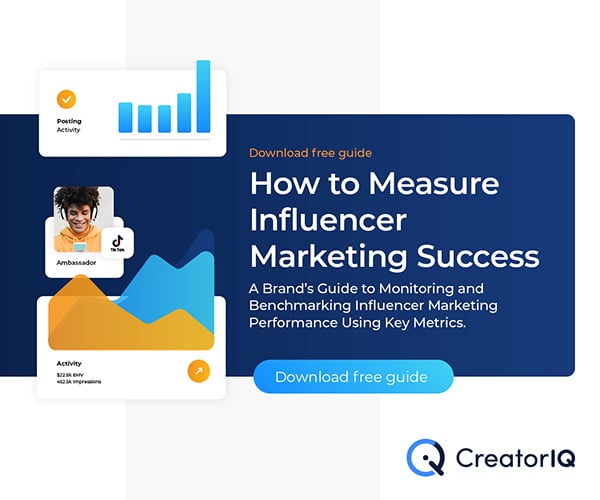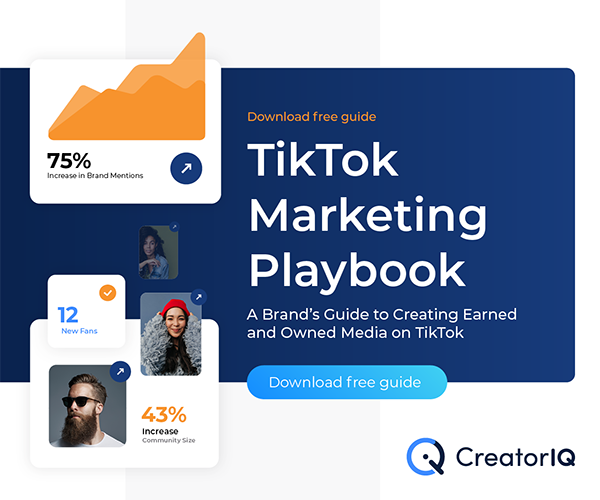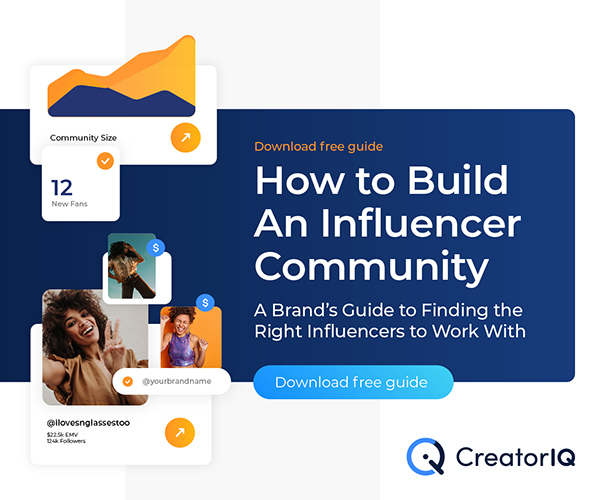How to Measure the Success of your Influencer Marketing Community
We're back for part 2 of our Guide to Measurement video series! In part 1, we discussed how to measure the success of an individual influencer relationship, but today, we're covering how to gauge the health of your influencer community as a whole. In this video, Taylor from Team Tribe walks through seven key metrics for tracking and benchmarking the overall impact of your influencer community. By monitoring trends in the composition and behavior of your entire network, you can identify opportunities to strengthen your influencer marketing program, and make informed decisions about how to best allocate your resources.


Don't have time to watch?
Read the transcript below.
Hi there. Taylor here from Tribe Dynamics, a CreatorIQ company, and I'm back for part two of our Guide to Measurement video series. In part one, we discussed how to measure the success of an individual influencer relationship. So be sure to catch up on that video, if you haven't already. But today we're going to discuss how to measure the success of your influencer community as a whole. In this video, we'll cover seven key metrics for tracking and benchmarking the overall impact of your influencer community. By monitoring trends in the composition, in behavior of your entire network, you can identify opportunities to strengthen your influencer marketing program and make informed decisions about how to best allocate your resources. We've got a lot to cover today. So let's get started.
Let's start with the obvious, community size. The larger your brand's community size or the number of influencers who mention your brand in a given time period, the greater your popularity among influencers and their followers. Community size tends to fluctuate throughout the year. So be sure to regularly check this metric to see whether your brand's network is expanding or contracting. A shrinking community indicates an opportunity to re-engage influencers who have previously mentioned your brand in order to rekindle their interest. You can also try reaching out to influencers who have mentioned brands or products that are similar to yours and try to bring these newcomers into your brand family.
Next, let's talk about retention. Many brands think that the best way to grow their influencer communities is by connecting with as many new content creators as possible. But actually, the most reliable and sustainable way to expand your brand's network and earn media presence is through retention, or sustaining the same influencer relationships quarter after quarter. Retention is crucial to long term success, because influencers with time honored connections to your brand are your strongest advocates. They help do the work for you by organically recruiting new brand fans through their genuine enthusiasm. If your brand is struggling to retain influencers, you may need to prioritize consistency in your influencer outreach. Your branch should take an always-on approach to community building by continually reengaging your most loyal content creators without neglecting to nudge those who have mentioned you in the past. While it is, of course, still important to connect with new influencers who align with your brand. We recommend that you devote the majority of your resources to the valuable influencers you've already retained.
Now, let's discuss three closely linked metrics that help you monitor the volume and impact of content created about your brand. Post count, post and frequency and influencer potency. Post count or the total number of posts mentioning your brand in a given time period measures the scope of influencer conversation happening about you. This metric is most helpful in the context of community size. A large volume of content may be expected from a large community, but it's particularly impressive from a small community. Because post count is closely tied to community size, you can use posting frequency or the average number of times each influencer in your community mentioned your brand over a given time period to glean just how prolific your average influencer is. Posting frequency then contributes to influencer potency, which is the average amount of EMV generated by each influencer in your community over a given time period. Growing influencer potency and posting frequency can indicate content creators increasing enthusiasm for your brand, while declining potency and frequency may suggest a slowing down of interest or engagement on content featuring your brand. If influencers in your community are posting less frequently and their potency is declining, it may be time to stir up conversation and brand affinity with an initiative like a virtual or in person event, a product send or a targeted relationship building campaign. Inspiring content creation isn't the be- all, end- all of influencer marketing. The goal is to ultimately galvanize consumers by monitoring your total engagements or the aggregate number of likes, comments and shares that influencer posts mentioning your brand receive in a given time period. You can better gauge how effectively your brand is connecting not just with influencers, but also with their followers. The more posts you're mentioned in, the higher your chances of garnering engagement. Because the total engagements metric is likely to scale with community size and post count, it's most helpful when examine in the context of these other metrics. If, for example, your total engagements are going down even though your community size and post count are stable, it might be helpful to check the engagement rates and fit scores of individual influencers in your community, which are metrics we discussed in part one of the series. To ensure that you're working with the best advocates for your brand.
Finally, let's bring it back to earned media value or EMV. EMV isn't just helpful for tracking the impact of individual influencers. It can also help you contextualize the success of your community as a whole. The EMV generated by your brand over a given timeframe represents the aggregate EMV driven by all of the content creators who mentioned your brand over that period. This metric is most useful in benchmarking your brand's performance in three ways. First, you can compare your brand's EMV for a particular time frame, be it this month, quarter or year to your EMV in a previous time frame to understand how your overall earned media footprint has changed. Or to see how your brand's influencer marketing program stacks up to the competition, you can look at your brand's EMV share among your competitors. What proportion of the total EMV driven by both your brand and your competitors over a given timeframe came from just your brand. The greater your share of EMV, the stronger your position within your competitive set. Lastly, you can use EMV to benchmark your brand's performance to the performance of your vertical. Tribe Dynamics' proprietary EMV index calculates the expected change in EMV that a brand in a particular vertical would experience between months, quarters or years based on general trends in that vertical. By comparing your brand's changes in EMV to your verticals EMV index, you can understand on a broad level how your brand's influencer marketing performance compares to other brands in your space. Keep in mind that EMV is directly affected by other key community metrics that we discussed today, like community size, posting frequency and total engagements. So you should never modify your influencer marketing program based on EMV alone, instead identify and act on the fluctuations in the foundational metrics that contributed to them.
Closely monitoring your brand's performance across a variety of metrics empowers you to set specific realistic goals, track your progress toward them and continually adjust your strategy based on the trends that you observe. I'm now going to leave you with three tips for using data and analytics to identify and achieve appropriate influencer marketing objectives as your earned media program matures.
The first tip is to set goals based on multiple metrics. No one metric by itself can speak to the success of your entire influencer marketing program. When determining targets for your brand to reach, incorporate a range of metrics to ensure that you're striving toward holistic and sustainable growth.
The second tip is to interpret data in context, influencer marketing metrics, like the ones we discussed today are deeply interrelated. Be sure to contextualize any growth or declines in specific metrics by surveying the full range of data about your brand, to identify and act on contributing factors.
Finally, the third tip is to prioritize long- term gains. Building and sustaining a large and passionate community of advocates is an ongoing process and it doesn't happen overnight. Rather than one off transactional partnerships that prompt short term spikes in total engagements in EMV, focus on fostering genuine and mutually empowering relationships with retained fans.
Thanks so much for watching today's video. We hope you feel empowered to leverage the metrics we discussed today to build strong and enduring influencer marketing programs, set achievable goals, and of course, measure your success along the way. If you haven't already, be sure to check out our guide to measurement report for a comprehensive look into all of the metrics we discussed, not only in this video, but also in part one. To learn how Tribe Dynamics', a CreatorIQ company, Influencer Marketing Analytics Platform keeps track of all these key metrics for you in one easy to use dashboard, request a demo. Of course, be sure to subscribe to our channel for more influencer marketing insights and best practices. We hope to see you again soon.
Watch More Videos on Influencer Marketing



